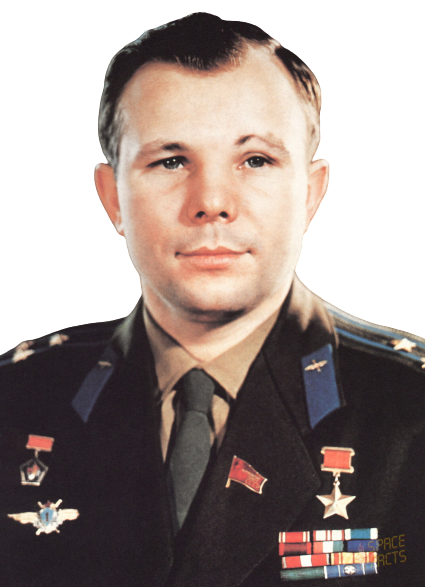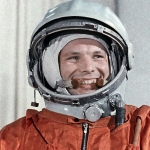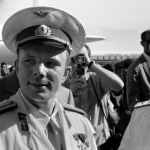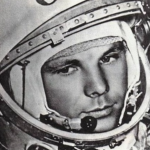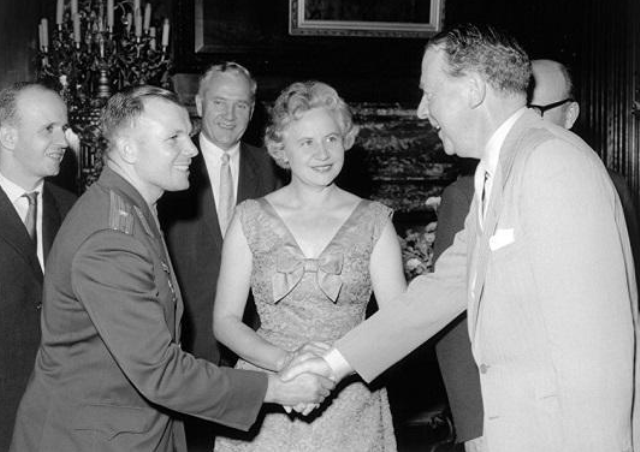
13.01.2023
The biography of Yuri Alekseyevich Gagarin is usually divided into two parts – pre-flight (27 years) and post-flight (7 years), which is reasonable: the rights and opportunities that the first astronaut had following his orbital flight were incomparable with those he had as an Air Force senior lieutenant. However, his responsibilities also grew immensely: Gagarin was no longer his own man, his life schedule was written months in advance, he was to become in the shortest possible time a diplomat and orator, a politician and a propagandist – as we would say today, a media figure of the highest class.
Since his actual work in the rocket and space sphere remained classified, the public was invited to follow Gagarin’s socio-political activities with admiration. Everything was transparent here: trips, endless rallies, endless receptions and banquets. That is probably why a contradictory impression of the “post-flight” Gagarin has been cemented in the grassroots memory of a generation Gagarin: say, he was good, of course, and helped people, but at the same time he drank too much and had too much fun. Needless to say, post-Soviet biographers and commentators did not want to ignore the “kitchen” mythology, and over the past two decades there have been a lot of materials in which the topic of the merry adventures of the first astronaut is actively relished. Some of the pseudo-historical anecdotes were collected in the books by Lev Danilkin (“Yuri Gagarin”, 2011), Jamie Doran and Pierce Bisoni (“Gagarin. The Man and the Legend”, 2011). Lovers of “strawberry” I send in search of these books, they are published in decent numbers – here we record the following: of course, Yuri Alekseyevich took part in a lot of public events, drank and ate, complimented women and even sometimes hooliganism, but not the dull “mundane” was the main content of his life after the historic flight. We will not be able to skip over some “touchy” episodes, but in general, today there is more than enough material to discuss the growth of Yuri Gagarin as a professional. Thanks to the publication of Kamanin’s diaries, on top of everything else we can compare Gagarin with other cosmonauts and conclude how well he continued to match the status of leader that was given to him for the first flight.
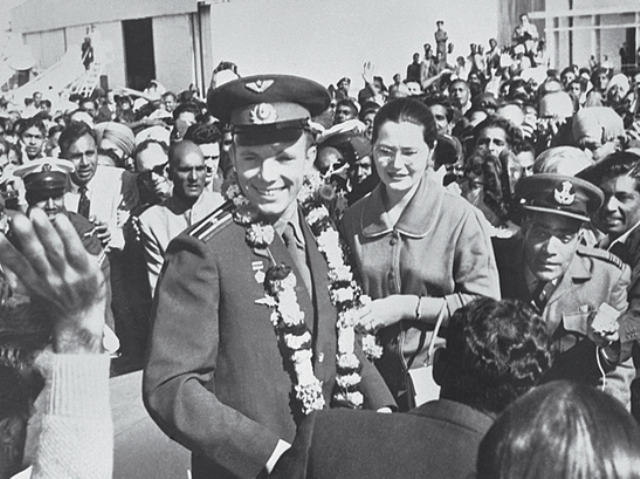
Let’s start with his trips abroad. In April 1961, the world marveled at another triumph of Soviet cosmonautics. Yuri Alekseyevich Gagarin was congratulated and wanted to be a guest in all civilized countries – official invitations were received from 80 countries! The Soviet political leadership eagerly responded to them in order to demonstrate the conditional “openness” of the USSR and get additional political dividends from public discussion of ceremonies, meetings, speeches.
Unfortunately, not as much information has survived about Yuri Gagarin’s foreign trips as one would expect. Some details can be found only in several books: Nikolai Kamanin’s “The First Citizen of the Universe” (1962), Nikolai Denisov’s “In Orbits of Peace and Friendship” (1963), “Good, Good, Gagarin!” (1963) and Nikolai Smirnov’s “On the Orbit of Friendship” (1963).
Strange, isn’t it? The topic is most auspicious, but it is as if a “conspiracy of silence” existed around it. There is only one explanation for such a situation: Gagarin was forbidden to talk about the rocket and spaceship, his teammates and creators of space technology, so his statements did not contain any new information and consisted mainly of propaganda cliches and demagogic generalizations, and squeezing something interesting out of the visits themselves against the background of the flights of new astronauts into orbit seemed a futile exercise.
Nevertheless it is necessary to remember the foreign visits, because the trips, especially the first ones, were a serious test for the cosmonaut: at that time he was formed as a public and political figure of high rank and a confident promoter of cosmonautics.
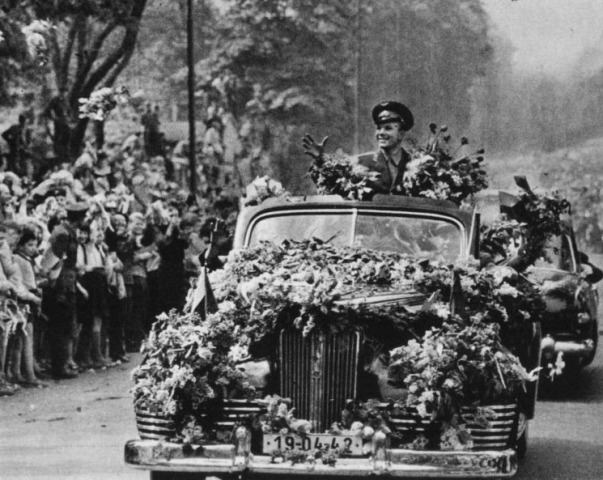
Usually a whole delegation accompanied Yuri Alekseyevich on his trips, but the main responsibility for the success of the events lay with Lieutenant General Nikolai Petrovich Kamanin, who knew from his own experience what world lifetime fame was and was going to pass on his knowledge to Gagarin. Interestingly, before the start of the tour, the cosmonaut underwent a five-day post-flight examination at the Central Research Aviation Hospital in Sokolniki. During his enforced detention he met and worked closely with correspondents of Pravda Sergey Alexandrovich Borzenko and Nikolay Nikolaevich Denisov, who were to make a literary record of Gagarin’s memories for the book “The Road to Space”.
The first country the cosmonaut went to was the Czechoslovak Socialist Republic (CSSR). On April 28, 1961 he arrived in Prague. Gagarin flew with a standard Tu-104 (No. 42389) carrying among its passengers students from United Arab Republic, citizens of China and Czechoslovakia and a group of Soviet tourists to Italy. The cosmonaut’s presence immediately caused a great deal of excitement; people lined up to sign autographs, and the crew commander, Pavel Mikhailovich Mikhailov (incidentally, a famous pilot and Hero of the Soviet Union) invited Gagarin into the cabin and gave him a book of his memoirs, “10,000 Hours in the Air” (1960). Yuri Alekseyevich asked the flight attendant to connect him to Prague: “I am flying to Czechoslovakia with a feeling of the deepest excitement, because now I am worried, perhaps, even more than during the space flight. I have flown around the globe, but this is the first time I am going abroad. And I am glad that my first foreign trip is a trip to the brotherly people of Czechoslovakia”.
When “Tu-104” taxied up to the building of Ruzin airport, it seemed to the passengers that the plane literally sank in the human sea. Everyone who met him tried to get to Gagarin, to shake his hand, to touch his shoulder, to tell him a few words… On the same day, after reception in Prague Castle (so called Czech fortress, which became the residence of state leaders) and a short rest, the cosmonaut visited one of the largest machine-building plants – “ČKD-Stalingrad”. Having learned that Gagarin was a former foundry worker, the workers made
a figure of a foundry worker in bronze overnight and presented it to the cosmonaut. Afterwards, Gagarin toured the sights of Prague and visited the National Liberation Monument on Vitkov Hill.
On April 29, 1961, the Czechoslovak newspapers published a decree awarding the foremost workers on the occasion of May Day. The list of those decorated began with the name of Yuri Gagarin: the president of the republic, Antonín Novotný, awarded the cosmonaut the honorary title of Hero of Socialist Labor of Czechoslovakia. At a solemn meeting in honor of this event, Gagarin excitedly thanked the Czechoslovak government for the high appreciation of his work:
“Allow me to address this high award to our Soviet people, our glorious Communist Party, its Leninist Central Committee headed by dear Nikita Sergeyevich Khrushchev”.
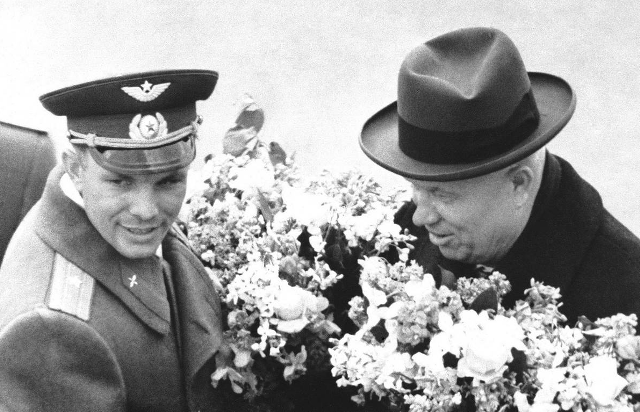
Returning from his first foreign trip, Yuri Gagarin first participated in the May Day demonstration on Red Square, and then on May 7 with his family went to Sochi. There at the Yavein Dacha (on the territory of the Sochi sanatorium; built on the site of a house, which before the nationalization belonged to the landowner Vasily Yurievich Yavein) were resting members of the cosmonaut squad; chief designer Sergei Korolev dropped in on them (and then came the famous collective photo, which many years later will be meticulously studied by Western experts). Taking advantage of the opportunity, Lieutenant General Kamanin and a group of specialists flew there on May 19 to discuss future manned missions into orbit. At an impromptu meeting, Korolev promised that at least ten launches of Vostok spacecraft would take place in the near future, after which flight and design tests of maneuverable three-seater Sever spacecraft would begin.
On May 22, 1961, Yuri Gagarin took off from the Adler airport for his second trip – to the People’s Republic of Bulgaria (PRB). This time instead of Kamanin he was accompanied by Evgeny Karpov, the chief of Cosmonaut Training Center. The IL-14 approaching Sofia was met by an honorary escort of jet fighters. Meanwhile, a solemn procession moved through the streets of the Bulgarian capital. The local leadership actually replicated the Moscow celebration of the cosmonaut, to the point that the festive rally began right at the airfield with a welcoming speech by Todor Zhivkov, First Secretary of the Central Committee of the Bulgarian Communist Party.
During this five-day trip, Gagarin visited several cities in Bulgaria. In Sofia and Plovdiv he was elected an honorary citizen of the city. He visited the famous monument on the Hill of Liberators (“Monument to Soldier Alyosha”) in Plovdiv and the majestic sculptural composition on the Shipka Pass. He met with the cooperators of the village Semenovets, with the residents of Pleven, Varna, Stara Zagora. Third-year students of the Agricultural Technical School of Preslav, in honor of Gagarin’s arrival, organized “Russian Language Week.” As in Czechoslovakia, the Bulgarian government wanted to reward the cosmonaut, and he was awarded the honorary title of Hero of Socialist Labor with the highest badge of honor – the Order of Georgy Dimitrov. In addition, on May 24 the cosmonaut took part in the celebration of the Day of Enlightenment, Culture and Slavonic written language (holiday “Cyrillic”), which was accompanied by mass dancing on the central square of Sofia. Interestingly, during the procession the column of demonstrators released pigeons. The spectacular show inspired Pavel Romanovich Barashev, a correspondent of Komsomolskaya Pravda, who was present there, to make a picture of the first cosmonaut with a white dove. After the demonstration he called several Bulgarian pioneers with birds, Gagarin took one of them in his arms. The pigeon pressed against his chest and opened wide its wings. The picture taken by Barashev at the time became the most replicated of all the images of Gagarin.
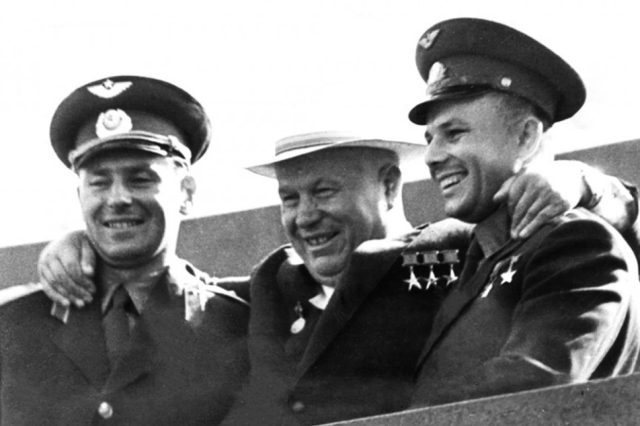
After visiting Bulgaria, the cosmonaut returned to Sochi, from where on June 1 the Gagarin family flew to Orenburg, where they spent a week. Of course, Yuri Alekseyevich was happy to see him at the 1st Chkalov Military Pilot School. From there, the Gagarins returned to Moscow. There, on June 8, the cosmonaut delivered a speech at the 10th Plenum of the Komsomol Central Committee, dedicated to preparing for the 22nd Congress of the CPSU: a whole report about his impressions in space (though without mentioning the problems that arose).
On June 13, Yuri Gagarin arrived in Kaluga – the city of theorist Konstantin Eduardovich Tsiolkovsky. There he participated in the laying of the Museum of Cosmonautics and delivered a speech at a rally dedicated to this extraordinary event. Probably after that he had an idea to organize his own museum in Zvezdniy Gorodok: the first exhibit was a figure of a foundry worker donated by the team of Czech factory CKD-Stalingrad. On June 17 and 18 the cosmonaut visited Gzhatsk and Klushin, visited relatives, teachers and school friends – it is clear that now the private visit turned into continuous rallies.
The third foreign visit of Yuri Gagarin was to the Republic of Finland. On June 30, 1961 the cosmonaut was invited by the society “Finland – Soviet Union” to go by train to the annual summer festival of Soviet-Finnish friendship in the city of Kemi. As he was moving, the number of passengers in the train carriage where Gagarin was traveling increased: everyone wanted to see him, talk to him, get his autograph. As usual, the cosmonaut was greeted at Helsinki railway station square by a huge excited crowd with homemade posters. One of the leaders of the association “Finland-Soviet Union” said on this occasion: “Our people are reserved, silent, reluctant to go to meetings. To shake us up, you need a… how shall I put it?… effect. A strong effect! It seems that the “effect” of Gagarin stirred many hearts”.
On his way to Kemi, the cosmonaut visited Hämenlinna (hometown of composer Jan Sibelius), Tampere (the 1st RSDLP conference was held there – a point Gagarin remembered in his opening speech in the market square – and the provincial capital of Oulu.

After hearing that the first cosmonaut himself would be at the party on July 2, not only Finns but also citizens of Norway and Sweden came to Kemi. On the platform Yuri Alekseyevich was met by a boy and a girl in national costumes. The choir sang the song “Conquerors of Space”. Then several burly guys picked up Yuri Alexeevich on their arms and carried him through a crowded station square to the podium. In honor of the cosmonaut there were performances of folk ensembles and sporting events. Delegations from various organizations brought gifts.
On July 4, Gagarin flew back to Helsinki, where a press conference was held. Western journalists pestered Gagarin with questions, to which he could only answer evasively. Nikolay Denisov, representing “Komsomolskaya Pravda”, gave the following example in his book “Ok, Ok, Gagarin!” (1963):
“There were about 50 people at the press conference. There were both young and old people representing various Finnish newspapers and magazines. Among them were correspondents of foreign agencies. Yuri Alekseevich was kindly seated at a small table in the corner and a cup of coffee was placed in front of him. Everybody puffed on their cigarettes, and after a few shots were taken by a rather impudent press photographer wearing a black business card, like at a wedding or a funeral, the first to attack was a representative of the American agency Associated Press, a tall lady with colored hair and gestures which were different from a man’s. In a masculine way, she also smelled a little of alcohol. – Mr. Gagarin,” she asked in broken Russian, “what brands of wine and cognac do you prefer?

Such an unexpected question was undoubtedly posed in order to lead her away from the main topic – about the achievements of Soviet science and technology – to trivia from the cosmonaut’s personal life, not essential, but to some extent “sensational” for some unpretentious newspapers and the same unpretentious readers. Smiling gently, Yuri tactfully explained to the American woman that Soviet cosmonauts, busy with their very responsible and complicated work, simply have no free time for detailed study of wine brands, as maybe some of the present people do. This answer drew laughter from everyone. It was obvious how many people liked the relaxed manner in which Gagarin made it clear to those journalists who came to “Vaakuna” to collect “juicy” details that they would not get anything out of this venture.
However, some of the friends of the American reporter still tried to “fight”. Two journalists from the right-wing press were especially active. The older one spoke Russian, and the younger one asked questions in Finnish and kept asking his neighbor if they were being translated correctly for Gagarin. You could tell by everything that these two were a well-coordinated, well-matched pair. They tried to make Yuri Alexeyevich answer the questions about the structure and equipment of our spacecraft, rockets and the very organization of flights in space, they insistently tried to get the information, which for the time being was not subject to disclosure. The older journalist even got into a sort of argument about the comparative advantages and disadvantages of American and Soviet rockets.
Smiling wickedly, Yuri Alekseyevich asked the correspondent to answer his, Gagarin’s, questions first. The latter fervently agreed.
“Tell me”, – asked Yuri Alexeyevich, – “what weight can American rockets lift?”
“About two tons”.
“And how much does the Soviet Vostok weigh? You probably know, because it was reported
in the press”.
“4,725 kilograms”, – said the disputant’s neighbor.
“Well”, concluded Gagarin, “almost five tons. So, Soviet rockets are two and a half times more powerful than American rockets”.
This rather illustrative lesson in arithmetic again cheered everyone up.

Indeed, all that was left to do was laugh. In the quoted fragment it is very clearly shown that the Soviets left no chance to get any specific information on any of the issues. It is impossible to ask about personal matters, because it takes you away from the subject of Soviet scientific and technological achievements. It is impossible to ask about achievements, because this is information that is not subject to disclosure. So, you can only ask about what has already been publicized in the Soviet newspapers. Gagarin seemed to take some pleasure in witty replies – he was young, venturesome, and apparently did not understand how humiliating it is when a correctly put question (even a “juicy” one) is answered without results, as if you do not deserve an answer. However, we must give the cosmonaut his due – he soon found the words that did not offend the correspondent, but made him an ally.
After the press conference, the Soviet delegation drove in cars to Turku (the port city, the ancient capital of Finland), where Gagarin met the workers of the railway workshops. They showed him their production, and he gave a short lecture to the local proletariat on the general basics of astronautics. The same evening, Yuri Gagarin was warmly received by President Urho Kekkonen. This audience was followed by a meeting with a delegation of local Communists, where Yuri Alekseevich was given a gold badge of the party. Yuri Gagarin’s fourth voyage abroad was a visit to one of the main bastions of Western civilization – Great Britain. Understandably, it aroused increased interest in the world, was covered in detail, and subsequently became surrounded by many myths. For example, studying this issue, I was surprised to find that there is still a popular story about a slice of lemon, which Gagarin allegedly took out of a cup of tea at breakfast with the Queen and ate at ease, demonstrating to the English court his “rustic roughness”. In reality, this “rusticity” episode looked somewhat different, but the important thing in this trip is quite different – in the post-war world, Britain’s status as a power has changed greatly, it was at a crossroads, and the political scale could swing in either direction, including a partnership with the Soviet Union. Did Yuri Alekseyevich understand that? Undoubtedly! And he did everything in his power to charm the stiff-necked British. The occasion for the visit was an official invitation sent by Dave Lambert, general secretary of the United Foundry Workers Union, who reasonably considered Yuri Gagarin a colleague and wanted to see him among the honorary members of his organization. The trip itself was decided to coincide with the opening of the Soviet trade and industrial exhibition in London.
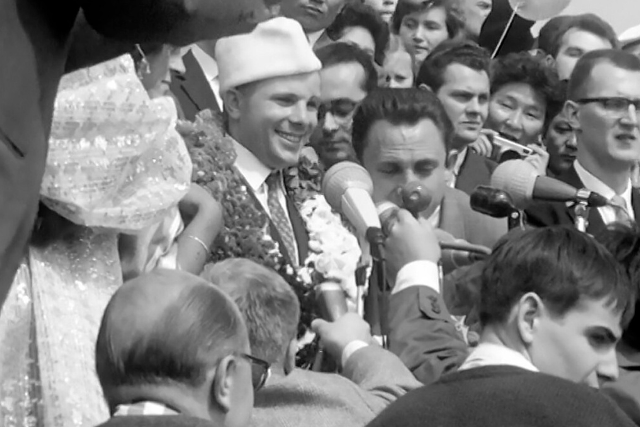
Interestingly, before the cosmonaut’s visit, there was a protocol collision. There were no instructions for the case of a foreign country receiving a cosmonaut. After a debate, the government decided that Gagarin would be met by Secretary of State for Science Francis Turnbull, which, of course, provoked derision from the acrimonious British. “The Daily Mail wrote: “Dear Yuri, excuse our protocol, but we have never met a man from space before”.
On July 11, 1961, the plane with the cosmonaut arrived at London airport. Although it was drizzling rain, tens of thousands of citizens took to the streets to enthusiastically greet Gagarin. He was given a car with a personal license plate “YG1”, which in a way redeemed the low status of the meeting: such an honour had only been afforded to the President of the United States in his time.
There was a small incident on the way to the Soviet Embassy. It struck the cosmonaut’s eye that as he drove along Embassy Street, on one side of which were private buildings and palaces, there was no one, and all the people meeting him were seated on the other side. He turned to face them and drove all the way down the street, answering the greetings of the Londoners. But it turned out that on the “free” side in the rain was Princess Margaret, who was a big fan of the idea of space flight. Gagarin, it turns out, did not pay attention to her, which was not slow to be echoed by the press.
However, the misunderstanding did not affect the program of the visit. In the afternoon, Gagarin and his entourage went to the Earls Court Exhibition Center, the home of the Soviet Trade Show. It must be said that it was rather modest, because Soviet manufacturers’ products could not surprise Englishmen who were used to advanced technology and variety. However, the appearance of the cosmonaut caused a stir. The townspeople who had gathered outside the center beforehand broke through the police cordons in excitement and surrounded the cosmonaut’s car, trying to shake his hand. The crowd chanted, “Yuri! Yuri!”

Gagarin gave a brief greeting in the Space Exploration Hall, followed by a press conference attended by about two thousand members of the media; the questions and answers were broadcast live on radio and television. Nikolai Nikolaevich Denisov recalled:
“Numerous questions from journalists were of the most varied nature. Representatives of American and Canadian newspapers, for example, were interested in Gagarin’s attitude to works of science-fiction nature published in the West.
“There are interesting books among them”, – Yuri Alexeyevich answered, – “and from the scientific and technical side they are close to reality. But it’s bad that the heroes of these books are drawn as supermen. The life shows that the space will be explored not by some supermen, but by the simplest, but well prepared people in all fields of knowledge. The builders of our spaceships, as well as all my fellow cosmonauts, cannot be classed as some kind of superhuman. They are all representatives of the working class of the working peasantry and our intellectuals. Just a few years ago, I was a foundry worker, and now I am a cosmonaut pilot. Look, do I look like a superman?”
Denisov’s testimony is amusing in that it is one of the classic examples of propaganda of the time, which was often used in relation to space achievements. Actually Gagarin could not seriously discuss Western fiction of his time because from the beginning of the 1930s it was published very rarely in Russian (the famous series of translated books of the publishing house Mir was started in 1965), therefore a Soviet reader could get his knowledge about it only from some magazine publications and retellings of the wicked literary critics. If Gagarin had had a chance to read Western fiction, he would have been convinced that it was exactly the opposite: in the early 1960s, it was principled to choose ordinary people from the “outback” as its characters – it was against this background that the heroes of Andromeda Fog looked like real superhumans.
After the press conference in the same room, William Maxwell, director of the British Interplanetary Society, presented Gagarin with a specially established medal for people who made a significant contribution to the exploration of outer space – Gagarin was the first to ever receive such an award.

Another unplanned event happened outside the Soviet embassy that evening. A girl, breaking through the autograph lovers, jumped up to Gagarin as he entered the building and kissed him passionately on the cheek. It was 23-year-old nurse Olivia Bryden who later told inquiring journalists: “Now I have made history – I am the first British girl to kiss him. I dared to do it as soon as I saw him – he was the very first one who made my heart flutter.”
On July 12, Yuri Gagarin visited the port city of Manchester, where the Executive Committee of the United Foundrymen’s Union was based and sent an invitation. There was a terrible downpour that day, and the organizers feared that the meeting would be disrupted. However, Gagarin once again showed his best side: seeing how many people came out on the streets to meet him, he drove the entire route, standing in an open car. The cosmonaut got so wet that he had to change his clothes before the union ceremony. Fred Hollingsworth, president of the foundry union, presented Gagarin with a certificate of election of the space hero as “honorary member of the number one union,” after which he pinned a gold medal on his chest, on which the words were stamped: “Together we will cast a better world. Then at the meeting, held in the factory yard, Yuri Alekseevich himself, who put on a ceremonial uniform on the occasion, made a speech. He spoke slowly, inserting English phrases into the Russian speech, “I am very glad to shake your calloused hands here in Manchester, who, like all countries, create the most beautiful things in the world. ‘…’ There will come a time when astronauts from various countries will meet as friends and colleagues on interplanetary stations and ships. There will be enough space for everyone. And Russians, and Americans, and the British.
Note: it was during the trip to Great Britain that the special style of the first cosmonaut’s speeches began to take shape, which he felt more intuitively than on the advice of his elders. He continues, of course, to mention the Party and the government, but more and more often his speeches slip into purely “space” rhetoric. Gagarin sensed that this was what was expected of him in the first place, not the routine incantations about “the struggle of the world proletariat for world peace,” and began to actively use it. Later he even rewrote the reports prepared for him, injecting the spirit of space romance into the boring meaningless texts, so that any listener, regardless of social status and occupation, felt his involvement in the greatest undertaking of mankind.
After the rally, the car carrying Gagarin drove through the cheering crowd toward Manchester City Hall, over which a red flag was hoisted. At the main entrance, a military band played the Soviet Union anthem. Mayor Biggs, who was wearing a gold chain for the occasion, invited his guests to lunch. Yuri Gagarin warmly thanked them for the warm welcome, handed out souvenirs and handed out hundreds of autographed photographs.
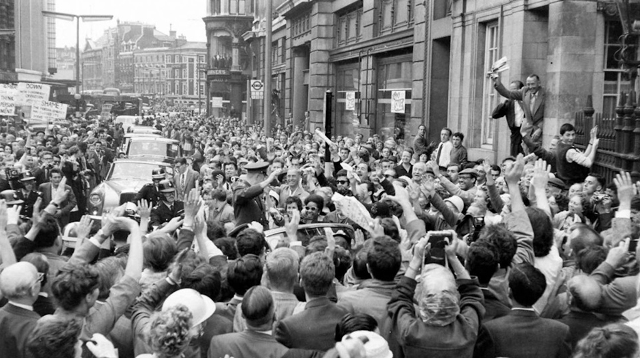
On July 13 the cosmonaut visited the Tower of London, he toured Wakefield Tower where the royal jewels are kept, including the crowns of the British monarchs. Then he paid a visit to Mansion House, the residence of Lord Mayor Bernard Waley-Cohen, after which he went to the Royal Society (British Academy of Sciences). Prominent English scientists, led by the society’s president, Howard Florey, were waiting for him there. After a moderated discussion on the prospects of space exploration, Flory presented Gagarin with two volumes of Isaac Newton’s correspondence as a gift.
Another highlight of the day was a visit to the temporary residence of Prime Minister Harold Macmillan, housed in the Admiralty. He showed the astronaut his office and the room where ministerial meetings are held. In gratitude Gagarin presented the premier with a book “The Road to Space” just sent from Moscow, which came as a complete surprise to Macmillan: he had to improvise and as a return gift Gagarin was given a silver plate with the monogram of the Royal Court.
From the residence, the astronaut, surrounded by thousands of Britons, went to the Cenotaph in Whitehall Street, a monument to fallen British soldiers and officers. There he laid a wreath of purple roses; on the ribbon was the inscription: “From Major Yuri Gagarin.
On the same day there was a reception hosted by the Minister of Aviation. Top officers of the British Air Force, famous pilots and squadron commanders honored the first cosmonaut of the planet. The conversation recalled the names of Soviet record-breaking pilots and paid tribute to the achievements of Soviet aviation. They talked about the planes shown at the parade in Tushino on July 9, 1961. One of the veteran colonels present spoke about his service in Russian aviation units during World War I. Then the interlocutors quietly moved on to the problem of confrontation between the powers, and here Yuri Gagarin spoke with great conviction of the need to overcome mutual mistrust on the way to a better, safer world.
The delegation was preparing to depart for the Soviet Union when it became known that the British Queen Elizabeth II wanted to invite the cosmonaut to a breakfast scheduled at Buckingham Palace. On the morning of July 14, four people went to the palace: Yuri Alekseyevich Gagarin, Nikolai Petrovich Kamanin, Soviet Ambassador Alexander Alekseyevich Soldatov and correspondent Nikolai Nikolaevich Denisov, full co-author of “The Road to Space”.
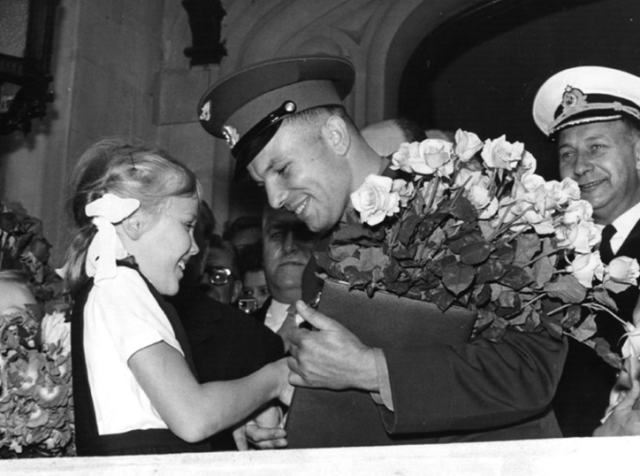
In the living room of the palace the cosmonaut and his entourage were greeted by Lord Louis Mountbatten, Chief of the Defense Staff, Keith Calder, the Chief Mayor of the capital, and Paul Briand, one of the leaders of the Conservative Party. Two dozen courtiers waited in the spacious reception hall, covered with a huge carpet of pale green shades, with windows overlooking the manicured park. And then a pleasant middle-aged woman, dressed in a modest gown, without any jewels or makeup, entered the drawing-room at an easy pace: she was the Queen of England. Behind her came her husband, Prince Philip, and her ten-year-old daughter, Princess Anne. After greeting everyone by the hand, Elizabeth II began to laugh, joke, ask Gagarin about his wife and daughters, about how he liked London and its inhabitants.
At the meeting an atmosphere of friendliness was immediately established. Soon everyone passed to a table laid in so-called White Hall – where more than one hundred years ago they received Tsar Nicholas I. Yuri Gagarin, of course, was briefed on the intricacies of protocol, so that he did not make any slip-up. However, such accelerated training was clearly not enough, and the cosmonaut found a completely unexpected move. Turning to the queen, he said: “I have never been in such high society before, and I don’t know at all how to behave properly. Please help me in this. Elizabeth II reassured Gagarin by saying that the subtleties of etiquette are also suggested to her by “experts”. Perhaps it was from this episode that the aforementioned tale of the lemon slice grew.
During breakfast, Yuri sat next to the queen, opposite them – her husband Philip, the Duke of Edinburgh, well versed in military aviation: he quickly found common ground with Gagarin. All the participants of the breakfast had a lively conversation. They talked not only about space – they also touched on politics, literature, art and sports. They talked about the past of the USSR and Britain and recalled prominent scientists.
After breakfast at Buckingham Palace, the cosmonaut for the second time went to the Soviet Trade and Industrial Exhibition for a short lecture to the students and went to Highgate Cemetery, where is buried the founder of the theory of the class struggle, Karl Marx, who was one of the “idols” for any Soviet man. Understandably, Gagarin could not bypass his grave. He laid a wreath of red and white carnations at the Marx monument, saluted, and stood beside it for two minutes in silence. In the evening, a reception was held at the embassy for the members of the Anglo-Soviet Friendship Society. On the morning of July 15, Gagarin left London for Moscow.
The cosmonaut managed to charm the British. It is said that his right hand hurt a lot from the continuous handshakes. However, he held firm, radiated friendliness, politely answered all kinds of questions. He became a true diplomat, able to rotate in any society and smooth out any awkwardness, including at the expense of his relaxed demeanor. He showed that a Soviet officer is not a drunken dubolom in an earflaps, a fur coat and valenki on top of a bear, but an intelligent witty man who can communicate even with the queen. He has managed to plant the seeds of hope that the Cold War is really coming to an end. Perhaps this visit could have helped to soften relations between Britain and the Soviet Union, but the Cuban Missile Crisis was ahead, almost bringing civilization to the brink of total annihilation.
